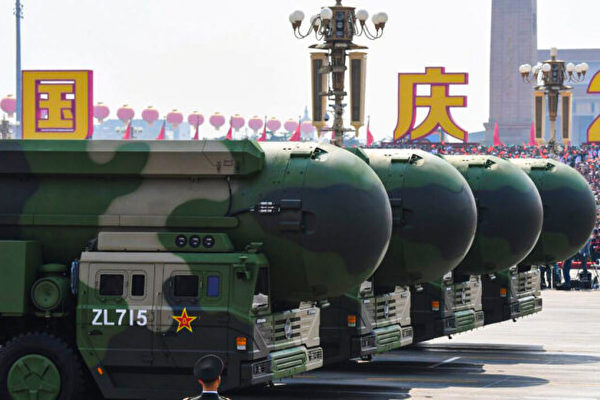The People’s Liberation Army (PLA) of the Chinese Communist Party conducted an intercontinental ballistic missile launch test towards the Pacific Ocean for the first time today (25th). Experts believe that the CCP is playing a double-edged strategy, engaging in warzone-level communication with the United States while simultaneously using military intimidation against other countries. This move may also aim to demonstrate that the Rocket Force, amid reports of severe corruption scandals, is “business as usual.” However, such actions by the CCP may lead the intimidated countries to unite further and find common ways to counteract.
According to Xinhua News Agency, at 8:44 on September 25th, the PLA Rocket Force successfully launched an intercontinental ballistic missile carrying a training simulation warhead into the relevant public sea area of the Pacific Ocean, landing in the designated area. The report also stated that this missile launch was part of the PLA Rocket Force’s routine annual military training arrangement, with China providing prior notification to relevant countries.
Analysts note that China rarely launches long-range missiles into the ocean, as usually, missile tests are conducted in remote provinces such as Inner Mongolia.
An observer cited by official CCP media “Observer Net” mentioned that China had only launched a rocket towards the South Pacific once in the past, during the 1980 “580” mission. That instance was for the scientific research launch of the Dongfeng-5 ballistic missile, whereas today signifies the first-ever practical intercontinental ballistic missile launch test conducted by the Chinese military towards the Pacific, seen as a display of nuclear deterrence.
The timing of China’s missile launch has drawn significant attention. It comes shortly after the resumption of warzone-level communication between China and the United States. General Wu Yanan, the Southern Theater Commander of the CCP responsible for military operations in the South China Sea region, recently attended the Indo-Pacific Defense Ministers’ Meeting in Hawaii and met with U.S. Indo-Pacific Command Commander Admiral Samuel Paparo. General Wu also met with representatives from the Philippines and other countries.
Retired General Yu Zongji, former Dean of the College of Political Warfare at Taiwan’s National Defense University, stated that the missile launch occurring after the Southern Theater Commander’s visit to the U.S. signifies China’s two-pronged strategy of communicating with the U.S. while also preparing for war. He believes this launch is a warning to the U.S. not to intervene in potential maritime conflicts between China and the Philippines.
Defense analyst Alexander Neill in Singapore told Reuters that given recent corruption scandals within the PLA Rocket Force, China must make external gestures, portraying that its highest military echelons are still functioning normally.
The rare intercontinental missile launch by China to showcase military power is juxtaposed with widely known internal corruption within the Rocket Force and the entire defense industry complex. Reports indicate that top military officials, including two Defense Ministers and three Rocket Force Commanders, as well as senior executives from military-industrial enterprises, have been investigated for corruption since last year.
Bloomberg reported on January 6th, citing sources, that U.S. intelligence revealed severe corruption within the Chinese Rocket Force and the defense industry, with missiles allegedly filled with water instead of fuel. The covers of numerous missile silos in western China were reportedly ineffective for missile launches. U.S. intelligence estimates suggest that military corruption has eroded confidence in the overall strength of the Chinese military, particularly in the Rocket Force, potentially diminishing the likelihood of significant military actions by Xi Jinping in the coming years.
“This action is to demonstrate externally that its strategic deterrence is still in operation,” Neill stated. Analysts find Beijing’s characterization of this test as a “routine arrangement” surprising.
Ankit Panda, an expert from the Carnegie Endowment for International Peace, expressed on social media that China’s description of this test as “routine” and “annual” is unusual since such activities are not carried out periodically or annually.
Some online observers noted that this missile was launched from Hainan instead of an inland silo, suggesting it might be a test for a mobile long-range missile system. U.S. defense analyst John Ridge suggested that China may view this test as a way to send a signal to the United States.
Former Pentagon official and Senior Research Fellow at the Lee Kuan Yew School of Public Policy in Singapore, Drew Thompson, analyzed on social media that China’s high-profile test during the United Nations General Assembly period is not only a signal directed towards the U.S., Japan, the Philippines, and Taiwan but also aimed at intimidating everyone.
Thompson stated that despite China claiming “this launch is not directed at any country,” tensions between China and Japan, as well as longstanding tensions with Taiwan, make this launch a strong and forceful warning to intimidate all parties.
General Yu Zongji told Epoch Times that China relies on military intimidation against neighboring countries like Japan, Taiwan, Vietnam, the Philippines, and India. He believes that following China’s recent actions, these countries will come together more closely to find common ways to counteract, potentially leading to the formation of a small NATO-like defense mechanism in Asia, promoting regional security.
Despite some improvements in relations between Beijing and Washington over the past year, the escalating threats posed by China in the Indo-Pacific region remain a key issue in U.S.-China relations.
In a report released last year, the Pentagon estimated that China’s nuclear arsenal comprises over 500 operable nuclear warheads, with about 350 being intercontinental ballistic missiles. The report also predicted that by 2030, China’s nuclear warhead count will exceed 1,000. However, compared to the 5,000-plus warheads in possession by the United States, China’s arsenal remains a small fraction.

